Fascinating research has been revealing yield increases, and other benefits, from adding biochar to digestor tanks during anaerobic digestion. Read on to find out about the emerging biochar anaerobic digestion benefits.
Anaerobic digestion is a process that turns organic waste into biogas, a renewable energy source. Many individuals and organizations are looking to optimize biogas production from anaerobic digestion for more efficient waste management and sustainable energy generation.
Did you know that adding biochar to the anaerobic digestion process can significantly enhance biogas production? Biochar, a charcoal-like substance made from organic materials, has been shown to improve methane production, reduce toxic metals, and enhance the degradation of organic waste such as food waste in anaerobic digesters.
In this article, we will explore how incorporating biochar in anaerobic digestion can help maximize biogas output while effectively managing organic waste. Let's discover the potential benefits of using biochar as an additive in anaerobic digestion!
Key Takeaways
- Biochar boosts biogas production by speeding up the breakdown of food waste and improving methane gas output.
- Making biochar involves heating organic materials in a low-oxygen environment. This process helps lock away carbon, which fights climate change.
- Biochar acts like a magnet for toxic metals during anaerobic digestion, making it safer for the environment.
- Adding biochar to anaerobic digesters can make biogas plants more profitable because it has been found in studies to make the system work better and produce more energy.
Overview of anaerobic digestion
Anaerobic digestion is a process that breaks down organic materials without oxygen. Microbes eat the waste and produce biogas, mainly methane and carbon dioxide. This happens in special tanks called anaerobic digesters.
I've seen these tanks turn things like food waste, manure, and sewage sludge into energy.
This method helps reduce harmful emissions from landfills by capturing methane for fuel. It's also great for making fertilisers from what's left after digestion. In my work with this technology, turning organic waste into resources has shown itself as a smart way to manage waste and generate renewable energy.
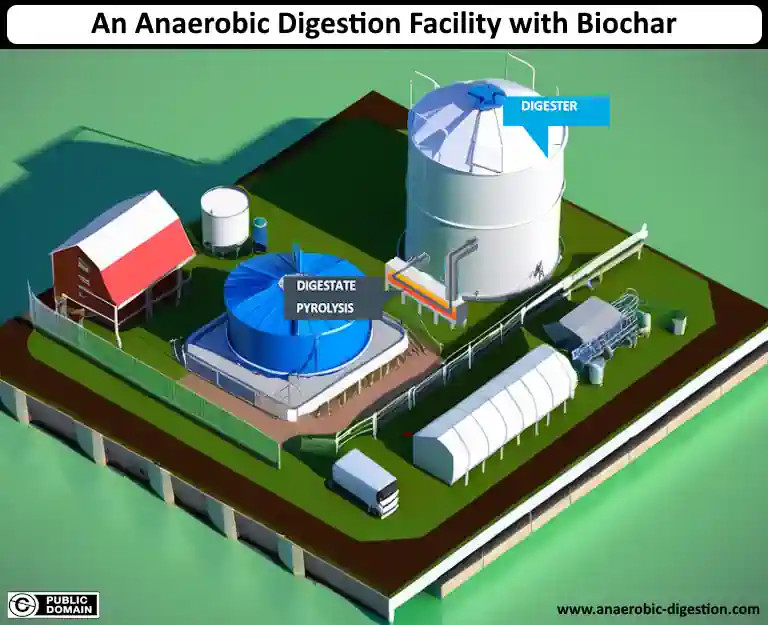
Importance of optimising biogas production
Optimising biogas production is crucial for turning waste into valuable energy with a good ROI. Making more biogas means we can use less fossil fuel, which helps fight climate change. It's about getting the most energy from things like food scraps and farm waste.
This process diverts waste away from landfills which in turn reduces methane emissions from landfills, cutting down greenhouse gases.
“Optimisation leads to sustainability.”
Biochar can add a big boost to this process. It improves how quickly and completely these materials break down in anaerobic digestion systems. By enhancing the interaction between microbial communities and organic matter, biochar speeds up gas creation and ensures toxic substances don't slow things down.
This makes producing biogas more effective and environmentally friendly, supporting global efforts in carbon sequestration and the circular economy.
Future Role of biochar in anaerobic digestion
It appears that in the future biochar will play a key role in anaerobic digestion by making the process more efficient. Anaerobic digestion breaks down organic matter, like food waste, without oxygen. Biochar helps this process by improving the environment in the digester tank for microbes that produce methane gas.
Studies show that biochar can reduce the inhibitory toxins that can slow down these microbes, resulting in more biogas production.
The work work done with biochar has shown it can also make the breakdown of organic material quicker. This means we get biogas faster and in larger amounts. Biochar acts like a sponge, holding onto important nutrients and water that help microbes thrive.
With biochar, the overall stability of anaerobic digestion improves too.
Next, let's explore how producing and using biochar affects its qualities and roles.
Production and Properties of Biochar
Biochar is produced through pyrolysis, a method involving heating organic materials in a low-oxygen environment. It exhibits high porosity and surface area, along with excellent adsorption capabilities due to its carbonaceous nature.
The use of biochar has shown promise in improving soil fertility and contaminant management.

Methods of biochar production
Biochar production involves turning organic materials into a stable form of charcoal through heating. This process improves soil health and locks away carbon, slowing down climate change. Here are the main methods used to create biochar:
- Pyrolysis: This method heats plant waste in a low-oxygen environment. I witnessed how, during pyrolysis, wood chips transform into biochar at temperatures between 350°C and 700°C. The heat breaks down the material into biochar, synthetic gas, and bio-oil. Pyrolysis is fast and efficient but difficult to control.
- Gasification: Similar to pyrolysis but at even higher temperatures, from 700°C to 1100°C. Gasification turns organic substances into biochar with an almost complete breakdown of the original material. It produces a smaller amount of char than pyrolysis but more energy-rich gases.
- Hydrothermal Carbonisation (HTC): HTC uses water as a medium for heating organic materials to 180°C – 250°C under pressure. I found this method fascinating because it works well with wet biomass like food waste or sewage sludge, which are otherwise hard to process.
- Torrefaction: This process lightly roasts biomass at temperatures from 200°C to 320°C in a low-oxygen setting. The resultant product has less mass but higher energy content per kilogram than the original biomass. It can be easiest to crush the biochar into powder for use as soil amendments or fuel pellets.
- Flash Carbonisation: Flash carbonisation can turn biomass into biochar within seconds by applying high pressure and temperature simultaneously. This quick method ensures less energy consumption and produces a consistent quality of biochar.
Each method has its specific applications and benefits, from enhancing soil nutrients to providing renewable energy sources while reducing greenhouse gases.
Physical and chemical characteristics of biochar
Biochar exhibits unique physical and chemical features due to its production process, usually through pyrolysis. This method transforms organic matter such as wood chips, manure, or leaves into a carbon-rich solid by heating it in an environment with little to no oxygen.
The resulting material has a high surface area, making it very porous. Because of my direct involvement in producing biochar from poultry litter, I've observed first-hand how this porosity enhances its ability to absorb water and nutrients.
On the chemical side, biochar is alkaline and can improve soil pH when added to acidic soils. It's rich in carbon but also contains other essential elements like hydrogen and oxygen in smaller amounts.
Its composition enables it to lock away carbon for centuries, acting as a significant carbon sink. This characteristic not only prevents carbon dioxide from entering the atmosphere but also enriches the earth where it's applied.
Role of biochar in contaminant management
Biochar helps clean water by grabbing harmful bits from it by attracting them electrically to adhere to the surface of the carbon (known as adsorption). This charcoal-like substance can capture heavy metals like zinc and lead, keeping them out of streams and rivers. In my work with soil remediation, I've seen biochar pull pollutants right out of the dirt, making the land safer for plants and animals.
It acts like a big sponge that soaks up bad stuff while letting clean water pass through.
“Biochar is like a magnet for contaminants; it's phenomenal in purifying our natural resources.”
Its structure also makes it great for dealing with smelly gases such as hydrogen sulphide. By adding biochar to waste treatment processes, these nasty odours get trapped before they can escape into the air.
Plus, this process turns harmful substances into less dangerous forms that are easier to handle or even beneficial.
Biochar's Influence on Anaerobic Digestion Process
Adding a sufficient amount of biochar improves cumulative methane output, however, excessive addition may hinder the AD process. Biochar can also improve AD process stability by enhancing buffer capacity, releasing volatile fatty acid buildup, and reducing ammonia inhibition.
Biochar enhances food waste degradation. It improves methane production and ameliorates toxic metals.
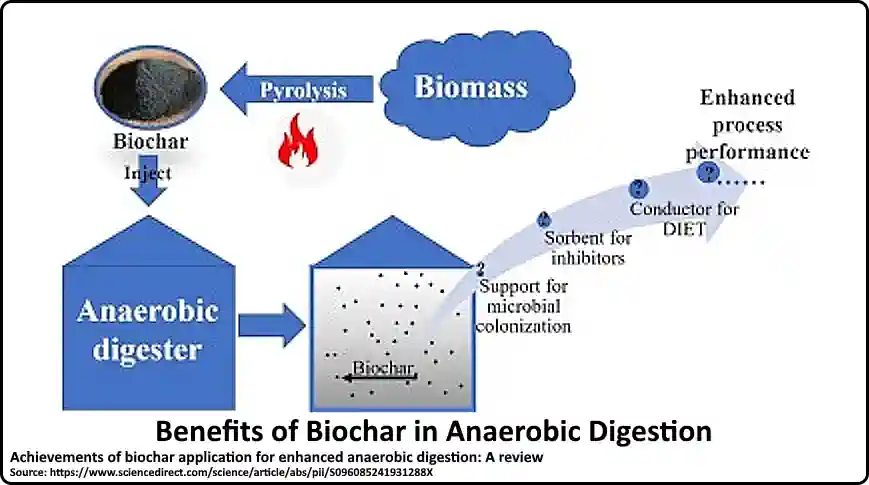
Enhanced degradation of food waste
Adding biochar to anaerobic digestion speeds up the breaking down of food scraps. This process makes methane gas quicker from leftovers. Biochar does this by helping microbes in the digesters work better and faster.
These tiny living things break food scraps into simpler parts, making more biogas.
In this setup, biochar acts like a sponge for bad stuff that can slow down digestion, such as toxins or heavy metals. It keeps these harmful elements away from useful microbes, ensuring they remain active and healthy.
This way, more food waste turns into energy without delay or trouble.
Improved methane production
Enhanced degradation of food waste leads directly to improved methane output. This process gets a big boost from biochar, as it increases the rate at which organic material breaks down in an anaerobic environment.
Biochar does this by improving the habitat for methanogenic archaea, key players in turning waste into biogas.
Biochar acts as a catalyst, speeding up the conversion of waste to energy.
By creating a more efficient process, biochar ensures that more methane is produced from the same amount of feedstock. This not only makes biogas plants more productive but also helps reduce greenhouse gas emissions by capturing carbon that would otherwise escape into the atmosphere.
Amelioration of toxic metals
Biochar plays a crucial role in ameliorating toxic metals during anaerobic digestion. This helps reduce the potential harm from heavy metals such as lead, cadmium, and arsenic.
The porous structure of biochar acts as an effective adsorbent for toxic metals, preventing their migration into the environment. Furthermore, biochar enhances the immobilisation of contaminants by promoting microbial activity. It also reduces heavy metal solubility through complexation and precipitation processes.
Through these mechanisms, biochar significantly contributes to mitigating the environmental impact of toxic metals present in waste materials undergoing anaerobic digestion.
Furthermore, it boosts confidence among environmental researchers, waste management professionals, and government officials about implementing environmentally sustainable approaches for managing organic waste while effectively addressing issues related to toxic metal contamination.
Implementing this method also aligns with efforts towards sustainable development goals by offering a safe path for repurposing organic waste material while ensuring minimal environmental impact from associated hazardous elements.
Entities: Biochar, Anaerobic Digestion Process
Economic Assessment
Analyzing the cost-effectiveness of adding biochar to anaerobic digestion can help in gauging its economic viability. This assessment focuses on comparing the expenses associated with integrating biochar against other waste management practices.
Read this in-depth analysis for valuable insights into optimising biogas production.

Cost-effectiveness of biochar in anaerobic digestion
Biochar is a cost-effective addition to anaerobic digestion systems. Biochar can be made by pyrolysing dried fibrous digestate from the AD process. The evidence shows that incorporating biochar enhances the process, leading to increased biogas production and more efficient waste management.
The economic assessment demonstrates that using pyrolysis to extract additional energy holds many possibilities, although more research and development is necessary. However, mounting evidence suggests that biochar offers significant benefits compared to other waste AD process optimisation methods.
Its main impact, when biochar is added at the optimum rate, will be to improve
- the plant's biogas yield stability,
- reduce operational costs and
- enhance energy production.
This makes it a cost-effective addition to further increase the financial viability of the AD process for organic waste management.
Related Entities are Biochar, Anaerobic Digestion Systems, Biogas Production, Waste Management Methods.
Comparison with other waste management methods
Optimizing biogas production through the addition of biochar in anaerobic digestion presents a compelling case for sustainable energy and waste management. This method, when compared to traditional waste management strategies, showcases distinctive advantages and efficiencies.
| Criterion | Biochar in Anaerobic Digestion | Traditional Waste Management Methods |
|---|---|---|
| Cost Efficiency | High initial investment but reduced operational costs due to enhanced gas output and waste processing efficiency. | Lower initial costs but higher long-term expenses due to less efficient resource recovery. |
| Environmental Impact | Enabling the diversion of waste away from landfills significantly reduces methane emissions from landfills and contributes to soil health when used as a soil amendment. | Higher greenhouse gas emissions and possible soil and water contamination from landfill leachate. |
| Energy Production | Enhances biogas quality and quantity, making it a more viable source of renewable energy. | Limited to no energy production, with a focus on waste reduction and disposal. |
| Waste Reduction | Highly efficient in reducing waste volume and mass through conversion to energy. | Depends on the method; landfilling minimally reduces waste volume, while incineration reduces mass but emits CO2 and can produce harmful by-products. |
| Sustainability | Promotes a circular economy by converting waste into valuable resources like energy and soil amendments. | Most methods offer limited sustainability benefits and can deplete resources over time. |
Integrating biochar into anaerobic digestion systems not only optimises waste recycling but also aligns with global efforts to mitigate climate change.
The mechanisms by which biochar influences the anaerobic digestion process will be explored next, offering insight into the science behind its benefits.
Mechanisms of Biochar in Anaerobic Digestion
Biochar enhances anaerobic digestion through redox reactions, fostering microbial community interactions and promoting denitrification. To learn more about these mechanisms and their impact on biogas production, delve into the potential of biochar in sustainable energy generation.
Redox reactions
Redox reactions involve the transfer of electrons between different chemical species. These reactions play a crucial role in anaerobic digestion by facilitating the breakdown of organic matter and the release of energy.
Biochar enhances redox reactions by serving as an electron shuttle, promoting microbial activity, and aiding in the conversion of complex organic compounds into simpler forms. This process leads to improved degradation of food waste in the digester, increased methane production, and reduction in toxic metals concentration within the anaerobic digester.
The involvement of biochar in redox reactions underscores its significance in optimising biogas production through the facilitation of electron transfer processes within the microbial community.
Microbial community interactions
Microbial community interactions within anaerobic digestion are crucial for efficient biogas production. Syntrophic relationships between bacteria and archaea facilitate the breakdown of complex organic matter into simpler compounds, such as acetate and hydrogen.
Then, these products are used by Methanosarcina to make methane. Methanosarcina is an important part of biochar-enhanced anaerobic digestion because it makes methane. Biochar's ability to absorb things also helps microbial diversity by creating homes for different microorganisms involved in different metabolic pathways. This makes the anaerobic digestion process more effective overall.
By incorporating biochar into the AD process, toxic metals are ameliorated by adsorption into the structure of the carbon molecules where they no longer interact to cause inhibition.
In this context, the use of biochar fosters a dynamic environment that encourages the growth and activity of diverse microbial communities essential for effective waste degradation and biogas generation.
The interactions between these microorganisms play a pivotal role in driving sustainable energy production through anaerobic digestion, offering a promising avenue for maximising biogas output while promoting environmental sustainability.
Concepts: synergetic relationships, bacterial metabolism
Role of biochar in denitrification
Continuing from the discussion on microbial community interactions, let's explore the role of biochar in denitrification. Biochar has demonstrated significant potential in mitigating nitrate pollution through denitrification.
By providing a conducive environment for denitrifying bacteria, biochar facilitates the conversion of nitrates to nitrogen gas, thus reducing groundwater contamination and eutrophication.
The porous structure of biochar offers an ideal habitat for denitrifying microorganisms and enhances their activity while also promoting the retention of nitrate ions.
Biochar positively impacts denitrification by fostering an environment conducive to anaerobic conditions necessary for denitrification processes. The strong sorption capacity of biochar aids in retaining nitrate and other nitrogen compounds within its matrix, effectively reducing their leaching into water bodies.
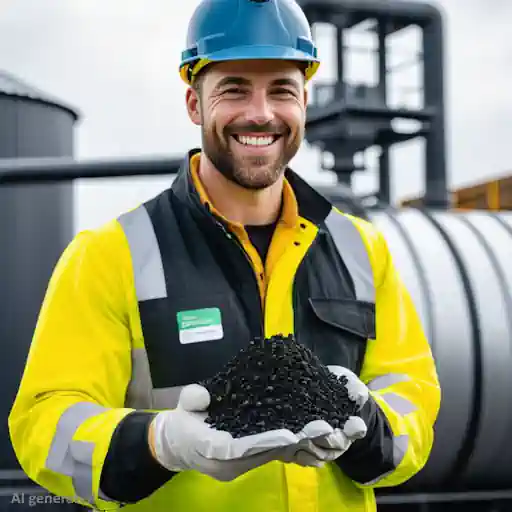
Potential for Sustainable Energy Production
Biochar serves as a sustainable energy source. It decreases methane emissions from landfills and contributes to waste management and greenhouse gas reduction.
Biochar as a source of energy
Biochar can be utilised as a sustainable source of energy, contributing to the reduction of greenhouse gas emissions. Its high calorific value makes it suitable for combustion, producing heat and power.
Additionally, biochar's potential in syngas production offers an alternative to natural gas for various energy needs. This presents a promising avenue for sustainable energy production, aligning with global efforts towards carbon capture and storage.
When pyrolysed at high temperatures, biochar releases combustible gases that can be harnessed as fuel. The controlled burning of biochar not only provides energy but also aids in waste management by reducing organic matter while capturing carbon from the atmosphere.
Reducing methane emissions from landfills
Biochar can play a pivotal role in reducing methane emissions from landfills. By implementing biochar as a landfill cover, it creates an oxygen-free environment necessary for the reduction of methane production.
This significantly mitigates greenhouse gas emissions and contributes to sustainable waste management practices. It also aids in controlling leachate generation, thus minimising environmental contamination.
Utilising advanced microbial processes through biochar incorporation fosters the decomposition of organic matter in landfills, leading to reduced methane emission levels. The specific microorganisms thrive due to the porous structure of biochar, enhancing their efficacy in breaking down organic compounds and diminishing methane release into the atmosphere.
Adding Biochar in Anaerobic Digestion – Conclusion
In conclusion, adding biochar to anaerobic digestion can significantly optimise biogas production. Using biochar enhances food waste degradation and improves methane production, leading to increased efficiency in the anaerobic digestion process.
Moreover, it offers cost-effectiveness and sustainable energy potential, making it a practical and efficient solution for waste management professionals and environmental researchers.
Implementing biochar in anaerobic digestion not only reduces greenhouse gas emissions but also contributes to a more sustainable approach to energy production. Therefore, exploring further into its mechanisms and potential applications is essential for maximising its impact on waste management and greenhouse gas reduction efforts.
Adding Biochar in Anaerobic Digestion FAQs
1. What is biochar, and how is it made?
Biochar is a carbon-rich material produced through the process of pyrolysis, where organic matter such as wood chips or crop residues are heated in a low-oxygen environment. This method transforms the materials into biochar, which can be used for various environmental applications.
2. Can adding biochar to anaerobic digestion improve biogas production?
Yes, introducing biochar to anaerobic digestion processes enhances methane production. Biochar acts as an adsorbent that improves microbial activity and stability within digesters, thereby optimising biogas output.
3. Why is biochar considered good for the environment?
Biochar contributes positively to environmental health by sequestering carbon from the atmosphere, thus aiding in global warming mitigation. Its use in soil also improves water quality and reduces greenhouse gas emissions from biomass that would otherwise decompose naturally.
4. How does biochar affect anaerobic digestion costs?
Whilst initial costs may increase due to the purchase of biochar, its addition to anaerobic digestion systems can lead to more efficient biogas production over time. This efficiency potentially lowers overall operational costs by increasing energy yield per unit of feedstock processed.
5. What role does biochar play in buffering capacity during anaerobic digestion?
Biochars possess alkaline properties enhancing buffering capacity against pH fluctuations within digesters; this ensures optimal conditions for acidogenic bacteria and methanogens necessary for stable biogas production.
6. Are there other benefits of using biochars in anaerobic digestion aside from optimising biogas production?
Beyond boosting methane yields, incorporating biochars into anaerobic digesters offers several additional advantages including improved process stability through enhanced adsorption of inhibitory substances like ammonia and hydrogen sulfide; this leads not only to better gas quality but also contributes significantly towards reducing odours associated with digestion processes.

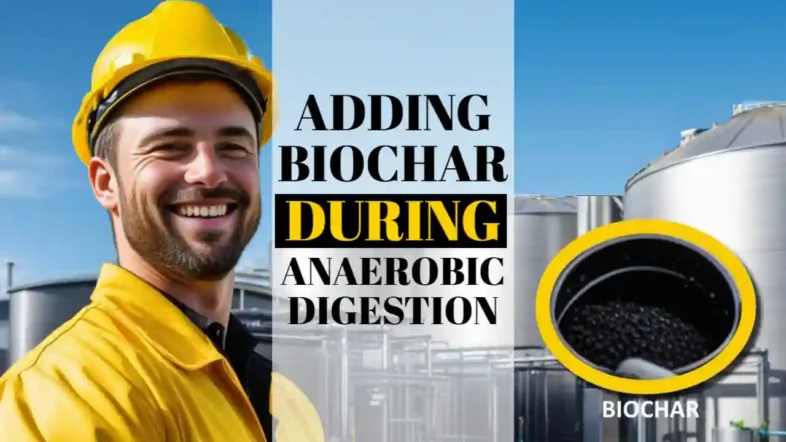
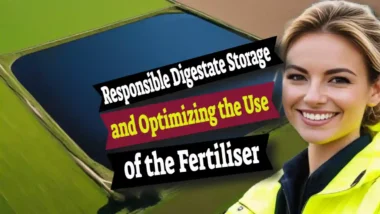


This sounds really interesting. But does any research exist on how this process affects the stability of the biochar when applying to soils? Is there a risk that it increases the decomposition rate of the biochar? If any research on this exists, please do share a link.
Good question, but I don’t know the answer.
As a biochar producer in Ireland, we are looking at a project with a group of universities to answer this very question. Our understanding is no. The carbon is sequested in the soil but research is vague that we can find so far
I am keen to know if this process affects the stability of the biochar when applied to soils.
Do you have any knowledge of how this process of using biochar in a biogas plant affects the permanence of the biochar?